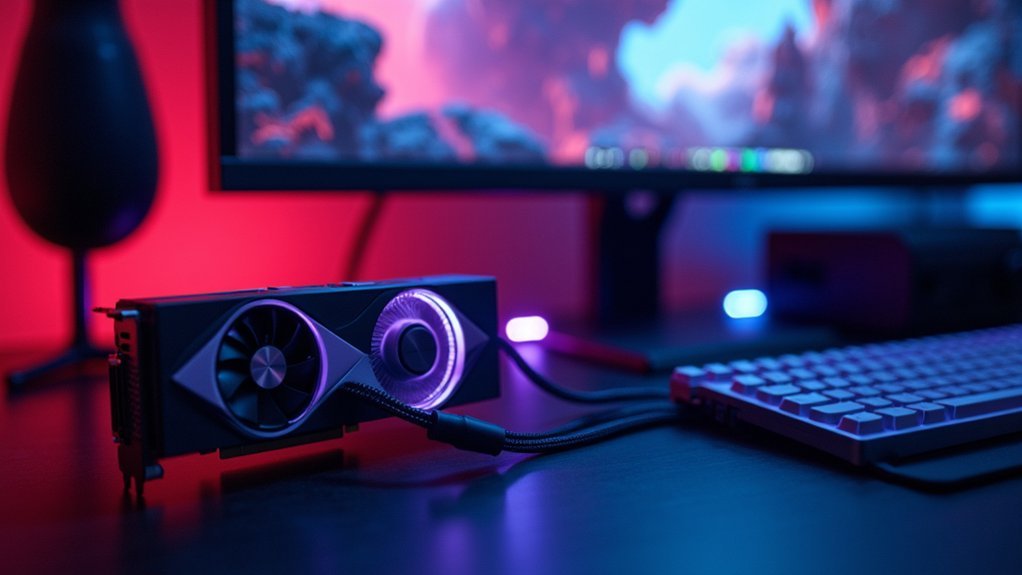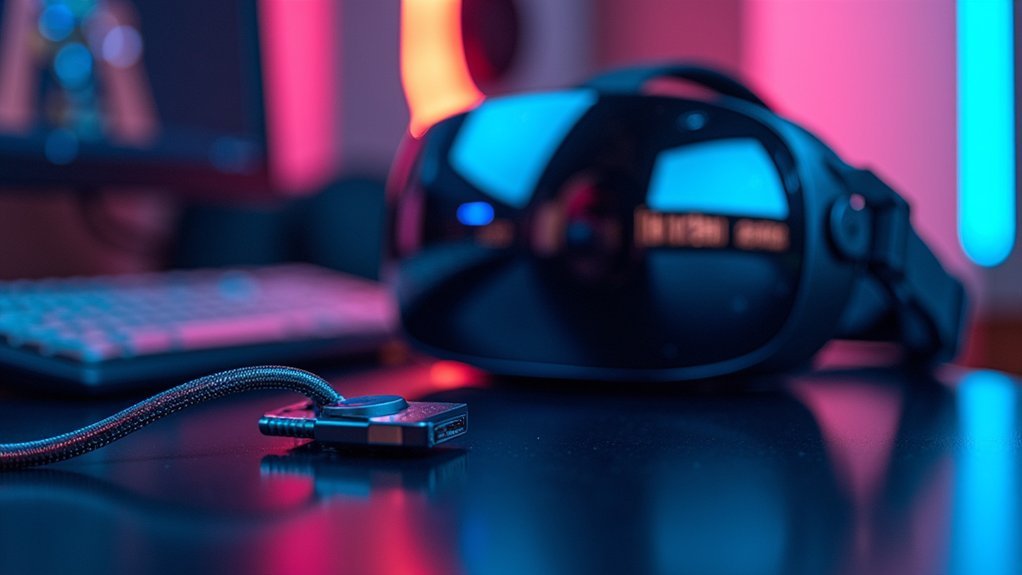You’ll need DisplayPort 2.1’s impressive 80 Gbps bandwidth for high-performance VR systems that demand ultra-high resolutions and refresh rates above 90 Hz. This latest standard supports dual 8K displays at 60 Hz with visually lossless Display Stream Compression, ensuring you won’t experience motion sickness or lag during intense gaming sessions. The enhanced 128b/132b channel coding delivers ultra-low latency while maintaining backward compatibility with your existing equipment, and the specifications below reveal how these technical capabilities transform your VR experience.
Understanding Bandwidth Requirements for VR Applications

When you’re setting up a VR system, bandwidth becomes your most critical bottleneck—modern VR applications demand massive data throughput to deliver the seamless, high-fidelity experiences users expect.
DisplayPort 2.0’s 77.37 Gbps capacity addresses these demanding requirements, enabling 8K resolution at 60 Hz with HDR for each eye. You’ll need this bandwidth to support high-resolution visuals and elevated refresh rates that prevent motion sickness and maintain immersion.
DisplayPort 2.0’s massive 77.37 Gbps throughput delivers true 8K VR experiences with HDR, ensuring smooth visuals that eliminate motion sickness.
Display Stream Compression optimizes your available bandwidth through visually lossless compression, maximizing video performance without sacrificing quality.
Multi-stream transport capabilities let you connect multiple displays simultaneously, essential for complex VR setups.
As VR applications continue pushing visual boundaries, you’ll find that upgrading to DisplayPort 2.1 becomes necessary to handle even more demanding data transfer requirements.
DisplayPort 2.1 Technical Specifications and Capabilities
DisplayPort 2.1 represents the latest advancement in display technology, delivering an impressive 80 Gbps maximum bandwidth that surpasses its predecessor’s already substantial capabilities.
You’ll benefit from its 77.37 Gbps data rate, specifically designed to handle high-resolution VR applications demanding substantial throughput.
Key DisplayPort 2.1 features for VR include:
- Visually lossless Display Stream Compression – Enables efficient 8K transmission while maintaining image quality
- Enhanced HDR capabilities – Supports immersive visual experiences with superior color depth
- Higher refresh rates – Delivers smoother motion critical for VR comfort
- Panel Relay capability – Optimizes power usage through partial display updates
- Ultra-High Bit Rate transmission and AdaptiveSync – Guarantees compatibility with next-generation VR technologies
These specifications position DisplayPort 2.1 as the premier interface for demanding VR applications.
Resolution Standards for Immersive Virtual Reality

As VR technology advances toward photorealistic experiences, you’ll need display interfaces that can handle increasingly demanding resolution requirements.
DisplayPort 2.0’s maximum payload bandwidth of 77.37 Gbps enables 8K resolution (7680 x 4320) at 60 Hz with HDR-10 capabilities, delivering the visual clarity vital for immersive virtual reality.
You’ll benefit from visually lossless Display Stream Compression that maintains image quality while supporting high refresh rates critical for smooth VR experiences.
The advanced features extend beyond single displays, supporting multiple display configurations for dual or triple 8K setups.
This capability dramatically enhances visual fidelity across your entire field of view.
Whether you’re developing VR applications or experiencing cutting-edge content, DisplayPort’s specifications guarantee you won’t encounter bandwidth limitations that compromise the immersive virtual reality experience modern headsets demand.
Refresh Rate Optimization for Smooth VR Performance
You’ll need to understand frame rate requirements when optimizing refresh rates for VR, as your headset typically demands 90Hz or higher to prevent motion sickness and maintain immersion.
Your DisplayPort connection must allocate sufficient bandwidth to handle these elevated refresh rates while supporting the high resolutions that modern VR requires.
You can leverage DisplayPort 2.0’s 77.37 Gbps bandwidth and DSC technology to achieve ideal display bandwidth allocation without compromising visual quality.
Frame Rate Requirements
When experiencing virtual reality, your visual system demands exceptionally high refresh rates to maintain the illusion of seamless motion and prevent discomfort. Frame rates below 90 Hz can trigger motion sickness, making consistent performance essential for your VR experience.
DisplayPort 2.0/2.1 addresses these bandwidth demands through advanced capabilities:
- Higher refresh rates enable dual 8K displays at 60 Hz for enhanced VR performance
- Display Stream Compression technology delivers visually lossless compression without quality sacrifice
- 90+ Hz minimum prevents motion blur and reduces latency for comfortable viewing
- 8K displays become feasible through improved data transmission capabilities
- Consistent frame rates maintain user comfort and immersion throughout extended sessions
You’ll achieve ideal VR performance by utilizing DisplayPort’s latest standards, ensuring your hardware can handle the intensive requirements of high-resolution, high-refresh-rate virtual environments.
Display Bandwidth Allocation
DisplayPort 2.0/2.1’s massive 77.37 Gbps payload bandwidth transforms how your VR headset allocates data streams for peak performance. This maximum payload enables sophisticated bandwidth management for high refresh rates and 8K resolution displays with HDR-10 support. You’ll experience Ultra-High Bit Rate capabilities that efficiently distribute data transmission across multiple streams.
| Feature | Bandwidth Allocation |
|---|---|
| 8K@60Hz HDR-10 | 48.6 Gbps |
| 4K@120Hz+ VR | 25.9 Gbps |
| DSC Compression | 3:1 ratio efficiency |
| Real-time Rendering | <20ms latency |
The visually lossless Display Stream Compression optimizes your bandwidth utilization without quality degradation. Advanced channel coding guarantees real-time rendering demands don’t overwhelm your system’s data transmission capacity, delivering seamless VR experiences.
Display Stream Compression Benefits in VR Gaming

You’ll find Display Stream Compression (DSC) revolutionizes VR gaming through its visually lossless compression technology that maintains image quality while reducing data overhead.
DSC’s bandwidth optimization methods enable you to experience 8K HDR content at 60 Hz over DisplayPort 2.0, maximizing your connection’s capacity without compromising visual fidelity.
This compression efficiency directly enhances frame rates by freeing up GPU resources, allowing you to achieve smoother motion and reduced latency during intense gaming sessions.
Lossless Compression Technology
Since virtual reality demands pixel-perfect visuals to maintain immersion, Display Stream Compression (DSC) has become a game-changing technology that delivers visually lossless compression without sacrificing image quality.
You’ll experience remarkably enhanced visual fidelity as lossless Display Stream Compression enables your VR setup to handle demanding high-resolution displays while maintaining crystal-clear imagery.
This technology transforms your virtual environments by providing:
- Support for 8K resolution at 60 Hz with HDR-10 capability
- Enhanced bandwidths up to 77.37 Gbps through DisplayPort 2.0/2.1
- Reduced latency ensuring smoother gameplay experiences
- Multi-stream transport capabilities connecting multiple displays from single outputs
- Higher refresh rates with improved color depth for realistic visuals
You’ll notice significantly improved immersion as DSC eliminates compression artifacts that traditionally plague VR gaming.
Bandwidth Optimization Methods
While traditional compression methods often sacrifice visual quality for reduced file sizes, Display Stream Compression revolutionizes VR gaming by delivering bandwidth optimization without compromising the pixel-perfect imagery that’s vital for immersion.
DSC’s visually lossless compression enables your VR system to handle massive amounts of video data efficiently, supporting 8K resolution at 60 Hz within DisplayPort 2.0’s 77.37 Gbps payload capacity.
You’ll experience enhanced virtual reality performance through DSC’s ability to maintain high resolution while enabling higher refresh rates and improved color depth.
This bandwidth optimization proves essential during fast-paced gaming scenarios where smooth motion and responsiveness matter most.
DisplayPort 2.1’s DSC integration guarantees your future VR headsets can leverage advanced display technologies for seamless multi-display configurations.
Frame Rate Enhancement
When VR gaming demands split-second reactions and fluid motion, DSC’s frame rate enhancement capabilities become your competitive advantage.
Display Stream Compression (DSC) delivers visually lossless compression that releases high refresh rates without sacrificing image quality, transforming your VR gaming experience.
With bandwidths of up to 77.37 Gbps through DisplayPort 2.0 and 2.1, you’ll achieve:
- Smooth 8K resolution gaming at 60Hz with HDR support
- Reduced GPU resource requirements for intensive VR sessions
- Consistent high frame rates in graphically demanding environments
- Minimized motion blur during fast-paced gameplay
- Enhanced user experience through seamless visual performance
DSC’s compression technology guarantees your VR headset maintains peak frame rates even in complex virtual worlds, giving you the fluid responsiveness essential for competitive gaming and immersive exploration.
HDR Support and Color Accuracy in Virtual Environments
As virtual reality environments become increasingly sophisticated, DisplayPort 2.0 and 2.1 deliver exceptional HDR support that transforms your visual experience through enhanced contrast and vibrant colors at resolutions up to 8K.
You’ll benefit from DisplayPort 2.1’s advanced 10-bit color depth, enabling precise color accuracy and smoother gradients in virtual worlds. The 77.37 Gbps payload capacity guarantees you can achieve high refresh rates while maintaining HDR quality for immersive VR experiences.
DisplayPort’s visually lossless Display Stream Compression preserves HDR capabilities during transmission, preventing quality degradation.
DisplayPort’s advanced compression technology maintains pristine HDR quality throughout signal transmission, ensuring zero visual compromise in demanding applications.
When you’re maneuvering fast-paced VR scenes, AdaptiveSync technology enhances color accuracy by eliminating screen tearing and guaranteeing fluid visuals.
This combination of HDR support and superior color reproduction creates more realistic virtual environments.
Multi-Display Configurations for Extended VR Setups
When you’re building extended VR setups with multiple displays, you’ll need to understand how DisplayPort’s Multi-Stream Transport (MST) technology can drive several screens from a single connector.
This capability becomes essential as you scale beyond single-display configurations to create immersive environments that span multiple monitors or VR panels.
You’ll also need to analyze the bandwidth requirements carefully to guarantee your DisplayPort 2.0 or 2.1 connection can handle the data throughput demands of your multi-display configuration.
DisplayPort Multi-Stream Transport
Multiple displays can transform your VR setup from a single-user experience into an expansive, multi-screen environment through DisplayPort’s Multi-Stream Transport (MST) technology.
This feature lets you connect multiple displays through a single DisplayPort connection, delivering the high-performance bandwidth essential for virtual reality applications.
MST capabilities vary considerably across DisplayPort versions:
- DisplayPort 1.4a supports two 4K UHD monitors or one 5K monitor from a single connector
- DisplayPort 2.0/2.1 enables dual or triple 8K displays with up to 77.37 Gbps bandwidth
- Enhanced refresh rates across multiple displays eliminate lag in VR experiences
- Professional VR integration creates expansive virtual environments for training and simulation
- Flexible resolutions accommodate various multi-display configurations for immersive setups
Bandwidth Requirements Analysis
Understanding these multi-display capabilities requires examining the specific bandwidth demands that extended VR setups place on your DisplayPort connection.
DisplayPort 2.0 delivers 77.37 Gbps maximum payload, enabling dual or triple 8K displays at high refresh rates for immersive VR experiences. You’ll benefit from visually lossless Display Stream Compression, which maintains image quality while reducing bandwidth requirements across multiple displays.
When you’re planning future-ready configurations, DisplayPort 2.0’s support for 16K resolutions guarantees your system can handle evolving VR content demanding higher resolutions and frame rates.
Multi-stream transport optimizes bandwidth usage by connecting several VR displays through a single cable, enhancing system efficiency in complex setups while maximizing your available data throughput for demanding applications.
Latency Reduction Through Advanced DisplayPort Features
While traditional display interfaces struggle with the demanding requirements of virtual reality, DisplayPort’s advanced features deliver the ultra-low latency that’s essential for immersive VR experiences.
You’ll benefit from enhanced channel coding that shifts from 8b/10b to 128b/132b encoding, dramatically improving data transmission efficiency. Display Stream Compression provides visually lossless compression while maintaining lightning-fast response times.
Key latency reduction features include:
- Maximum payload of 77.37 Gbps enabling faster data transmission
- Display Stream Compression minimizing delays while preserving image quality
- Enhanced 128b/132b encoding improving transmission efficiency
- Support for 8K resolution at 60 Hz with high refresh rates
- Bidirectional data communication through auxiliary channels for real-time adjustments
These specifications guarantee smoother visuals that reduce motion sickness and enhance your overall user experience in virtual reality environments.
Compatible VR Headsets and Hardware Requirements
The convergence of cutting-edge VR technology and DisplayPort connectivity has created a new standard for immersive experiences.
You’ll find that high-performance VR headsets like the Oculus Rift S and HP Reverb G2 require DisplayPort connections to achieve the best high resolution and refresh rates.
DisplayPort 1.4a supports 5K resolution through a single cable, while the latest DisplayPort 2.0 enables 8K resolutions at 60Hz for next-generation headsets.
You’ll benefit from Display Stream Compression, which delivers visually lossless streaming without compromising quality.
However, you must guarantee adequate GPU resources, as these performance requirements demand significant encoding power.
Your graphics card needs sufficient capability to handle high-resolution rendering with minimal latency, making GPU selection critical for the best VR experiences.
Cable Standards and Certification for VR Systems
Five critical certification standards determine whether your DisplayPort cable can deliver the bandwidth necessary for high-end VR experiences.
When selecting cables for VR systems, you’ll need to understand how certification affects performance and data transmission quality.
- DP8K and DP40 certifications guarantee your cables meet minimum standards for high bandwidth VR applications.
- DP80 certification delivers the full 80 Gbps bandwidth that DisplayPort 2.1 offers for premium VR performance.
- Cable length limitations restrict ideal performance to 2 meters or less for maintaining HBR3 support.
- Universal compatibility exists across DP devices, but not all cables support maximum bandwidth levels.
- 128b/132b encoding in newer cable standards enhances data transmission efficiency compared to older 8b/10b methods.
Power Efficiency Considerations in VR Display Technology
Beyond selecting certified cables that can handle VR’s demanding bandwidth requirements, you’ll need to contemplate how efficiently your DisplayPort setup manages power consumption during extended VR sessions. DisplayPort 2.1’s Panel Replay capability enables partial screen updates, dramatically reducing overall system power consumption. The visually lossless Display Stream Compression optimizes bandwidth performance while maintaining visual quality, contributing to better power efficiency.
| Feature | Power Efficiency Benefit |
|---|---|
| Panel Replay | Reduces power through partial updates |
| DSC Technology | Optimizes bandwidth while preserving quality |
| High Refresh Rates | Enhanced thermal performance in compact headsets |
| USB Data Transfer | Eliminates need for additional power sources |
High dynamic range (HDR) at elevated resolutions provides immersive experiences through optimized data transmission, ensuring your VR sessions maintain efficiency without compromising visual fidelity or thermal performance.
Backward Compatibility With Older Displayport Versions
When upgrading to newer DisplayPort versions for VR applications, you won’t need to replace your entire existing setup since DisplayPort 2.0 and 2.1 maintain full backward compatibility with all previous versions.
This backward compatible design offers several advantages for VR users:
- Your existing DisplayPort 1.4 cables and devices will function seamlessly with newer hardware.
- You can gradually upgrade components without discarding previous investments in display technologies.
- Video conversion to HDMI, DVI, and VGA remains supported through simple adaptors.
- All DisplayPort cables work with any DisplayPort device, regardless of certification level.
- You’ll access higher-performance features while preserving your current existing display setups.
This compatibility approach eliminates the need for complete system overhauls, making it cost-effective to adopt advanced VR capabilities while maximizing your current hardware investments.
Future-Proofing VR Systems With Displayport 2.1
As virtual reality technology continues advancing toward higher resolutions and more demanding visual requirements, DisplayPort 2.1 emerges as the definitive solution for future-proofing your VR systems.
With its 80 Gbps maximum bandwidth and Ultra-High Bit Rate (UHBR) capabilities, you’ll handle 4K and beyond resolutions effortlessly. The visually lossless Display Stream Compression (DSC) guarantees exceptional visual quality without performance compromises in high-performance virtual reality applications.
DisplayPort 2.1’s 80 Gbps bandwidth and visually lossless DSC deliver uncompromised 4K+ VR performance for demanding applications.
You’ll benefit from adaptive sync features that eliminate latency during fast-paced gaming and simulations.
DisplayPort 2.1’s certification program assures enhanced features like Panel Relay and DSC compliance, providing future-proof compatibility for next-generation VR displays. This investment protects your system against evolving VR demands while delivering the bandwidth necessary for tomorrow’s immersive experiences.
Performance Comparison Between DisplayPort and Alternative Interfaces
While DisplayPort stands as the gold standard for VR connectivity, you’ll find significant performance gaps when comparing it to alternative interfaces.
DisplayPort’s superior video bandwidth performance enables true high-performance virtual reality through several key advantages:
- DisplayPort 1.4a delivers 5K resolutions for immersive experiences that HDMI 2.0 simply can’t match
- DisplayPort 2.0’s 77.37 Gbps bandwidth supports dual or triple 8K resolutions for next-generation VR
- Display Stream Compression guarantees visually lossless transmission unlike older DVI and VGA connections
- High refresh rates with low latency outperform USB-C 3.0’s VR streaming capabilities at lower resolutions
- Enhanced supersampling support through tools like Oculus Quest Debug Tool optimizes tethered VR connections
You’ll discover that DisplayPort’s advanced features make it indispensable for demanding VR applications.
Frequently Asked Questions
Can DP 2.0 Do 4K 240HZ?
Yes, you can achieve 4K 240Hz with DisplayPort 2.0. You’ll get this performance through its 77.37 Gbps bandwidth and visually lossless Display Stream Compression, ensuring you won’t notice any image quality degradation.
Is Displayport 1.2 or 1.4 Better?
DisplayPort 1.4’s better than 1.2 because you’ll get higher bandwidth, 5K resolution support, Display Stream Compression, and improved HDR capabilities. You’ll experience better performance for demanding applications requiring high refresh rates.
How Much FPS Can Displayport Handle?
You’ll get different fps depending on your DisplayPort version and resolution. DisplayPort 1.4 handles up to 120 fps at 4K, while DisplayPort 2.0 can push 240 fps at 4K resolution.
What Is the Difference Between DP40 and Dp80?
DP40 offers 40 Gbps bandwidth for high-resolution displays, while DP80 doubles that to 80 Gbps. You’ll get higher refresh rates, better color depth, and enhanced performance for gaming and VR with DP80.





Leave a Reply